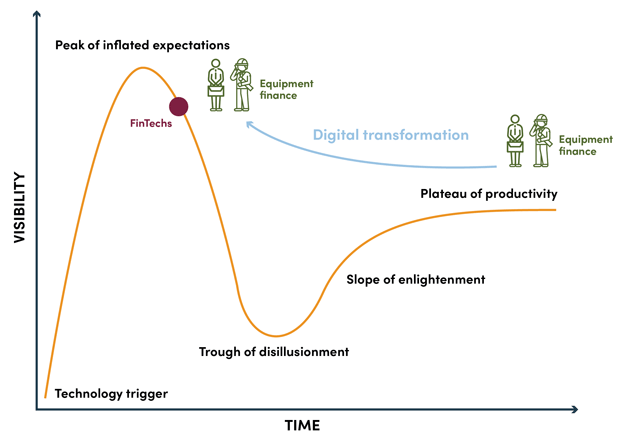
The recent shift from CAPEX to OPEX economics has created significant new demand for equipment finance. That demand is attracting new, technology-centric participants to the industry, most notably fintechs offering consumer-like solutions. This combination of new demand and new competitors has brought equipment finance to a turning point where business-as-usual is no longer an effective approach and the risk of stalling out is a real probability.
The risk exists because these “new” competitors come from a world where competitors work together to deliver customer experiences that are seamless and convenient. Experiences that can only come from the interoperability and flexibility of systems designed using industry specific standards.
As a lifelong student of technology, I have often lost sleep over the Gartner Hype Cycle. The Hype Cycle, first introduced in 1995, is not about products or simple applications of a technology. The Hype Cycle maps social acceptance of new technologies and forecasts the success or demise of entire industries when technological disruption is at play. Such is the case right now in finance and banking due to the changes from new competitors entering the market and the technology, largely driven by digital transformation including cloud architectures, data analytics, machine learning, AI, and cryptocurrencies.
As the figure below shows, prior to the most recent wave of digital technologies, equipment finance was a stable industry on the Plateau of Productivity. At this stage, business processes are matured, and growth is stable and reliable – even during something like a pandemic. But the new digital technologies enabled by the massive scale and low cost of cloud computing have triggered new offerings and increased the number and types of fintech competitors. These include digital lending and credit, mobile banking, mobile payments, cryptocurrency & NFTs, insurance, mobile trading, and banking as a service (BaaS).

Digital Transformation has pushed equipment finance back to the peak of the Hype Curve.
The leaders of traditional finance and banking companies are spending heavily on consultants and new strategies trying to defend their market shares of consumer and commercial lending. But the risk of the Peak of Inflated Expectations is that new products fail to “cross the chasm” and industry leaders fail to change culture fast enough to get out of the Trough of Disillusionment that follows the hype. Disillusionment affects business innovators and customers alike – they often lose interest in using the new technology. But the risk for businesses is that they stall in their efforts to transform and keep up with more agile users of the new technology.
The good news is that the Hype Curve is a technology adoption curve and so participants have a level playing field when it comes to customers and social norms. The trick, then, is to find ways to avoid disillusionment both internally and through the ecosystem in which the technology is deployed. Much of the work in this regard is being done for finance companies by the consumer banking and commerce markets. Users, both consumer and commercial, have come to trust and adopt online financial transactions. Mobile technology has blazed a trail for everyone with Multi-Factor Authorization (MFA), QR code and “tapping” interactions with the physical world, electronic document generation and signatures, and best-in-class user experiences – both mobile and desktop.
But equipment finance, like their regulated cousins in healthcare, lags new competitors emerging from the consumer eCommerce and lifestyle space in one very important way – industry standards. Data compartmentalization, non-interoperability, paper documents, and siloed-by-design software still dominate patient experiences. Healthcare systems frustrate physicians and patients alike with the inability to transfer patient data between providers and those using electronic health records including EPIC, Anthem or Cerner.
In equipment finance, migrating from one back-office system to another typically takes 12 to 24 months because the data schemas differ not only between service providers but also between customers often using the same system. Origination systems are rebuilt from the ground up because just like every health insurance company that has a better way to do prior authorizations, every lessor has “a better way to do credit.” When exciting new offerings like digital signatures and virtual notary services become available, interoperability has to be accomplished with custom integrations and middleware, rather than APIs – causing frustration and disillusionment can set in.
Standards Lead to Enlightenment
This is where the fintechs have an advantage. They come from the technology world rather than the finance world and understand how industry standards facilitate growth. They have the tools they need to take advantage of new offerings and reach the Slope of Enlightenment. A recently formed standards group for solar energy devices summarizes the power of standards:
The main purpose for industry standards is to make different products compatible with each other and to ensure customers that they can safely mix and match products from different brands. They drive industry innovation, cost reductions, and enable a variety of cost-effective, simple-to-use, holistic solutions. — SunSpec.org
Better customer experience, more innovation, reduced costs, and more complete solutions are advantages that fintechs already enjoy and await equipment finance operators if they adopted a standards approach. Here are the three areas standards could impact within equipment finance:
- Origination Workflow – standard applications and background documents
- Data Schema terminology – a common structure for equipment finance data
- Business Intelligence lexigraphy – a common language for the business
Paul Weigmann of the Rotterdam School of Management describes three modes of creating industry standards: committee-based, market-based, and government-based. Weigmann believes that hybrids of these modes will work best and since equipment finance is already regulated by government policy, this is a given. Industry groups like NEFA, ELFA, and the AACFB could play a role in setting up committee-level discussions. These committees should include industry leaders from the lending community to make sure decisions are practical and effective as well as serve providers that can drive the market changes needed to deploy the standards in their products.
Digital technology has changed equipment finance’s position on the Hype Cycle and in so doing, enabled new competitors to enter the market. The industry will have to do more than the usual incremental, independent adjustments to compete with technology-centric players. One of the advantages of coming from a mature, stable position on the cycle is that industry leaders know what matters to customers and how to make a difference – since they have struggled with non-standard systems for a long time. If they work together, they can restart the industry’s engine and avoid a stall.
Editor’s note
At the ELFA Convention there will be a discussion entitled “Change is on the Horizon: Is Equipment Finance Ready for Standardization?” featuring the author of this article alongside representatives from GreatAmerica, Leasepath, Reimagine Advisors, Solifi and Syndifi.